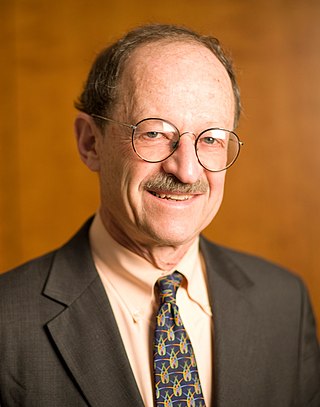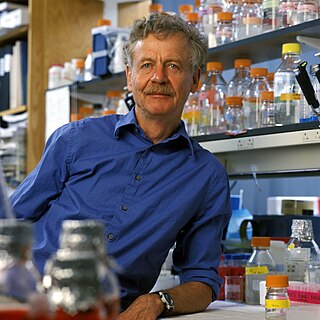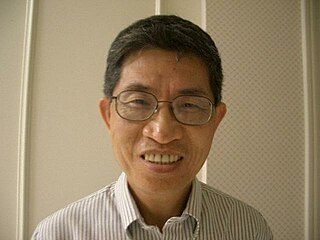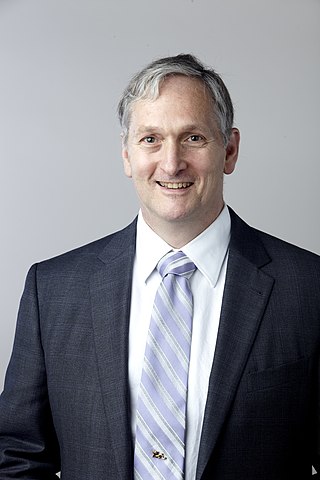Related Research Articles

An oncogene is a gene that has the potential to cause cancer. In tumor cells, these genes are often mutated, or expressed at high levels.

David Baltimore is an American biologist, university administrator, and 1975 Nobel laureate in Physiology or Medicine. He is a professor of biology at the California Institute of Technology (Caltech), where he served as president from 1997 to 2006. He founded the Whitehead Institute and directed it from 1982 to 1990. In 2008, he served as president of the American Association for the Advancement of Science in 2008.

Howard Robert Horvitz ForMemRS NAS AAA&S APS NAM is an American biologist best known for his research on the nematode worm Caenorhabditis elegans, for which he was awarded the 2002 Nobel Prize in Physiology or Medicine, together with Sydney Brenner and John E. Sulston, whose "seminal discoveries concerning the genetic regulation of organ development and programmed cell death" were "important for medical research and have shed new light on the pathogenesis of many diseases".

Harold Eliot Varmus is an American Nobel Prize-winning scientist. He is currently the Lewis Thomas University Professor of Medicine at Weill Cornell Medicine and a senior associate at the New York Genome Center.

Phillip Allen Sharp is an American geneticist and molecular biologist who co-discovered RNA splicing. He shared the 1993 Nobel Prize in Physiology or Medicine with Richard J. Roberts for "the discovery that genes in eukaryotes are not contiguous strings but contain introns, and that the splicing of messenger RNA to delete those introns can occur in different ways, yielding different proteins from the same DNA sequence". He has been selected to receive the 2015 Othmer Gold Medal.

Robert G. Roeder is an American biochemist. He is known as a pioneer scientist in eukaryotic transcription. He discovered three distinct nuclear RNA polymerases in 1969 and characterized many proteins involved in the regulation of transcription, including basic transcription factors and the first mammalian gene-specific activator over five decades of research. He is the recipient of the Gairdner Foundation International Award in 2000, the Albert Lasker Award for Basic Medical Research in 2003, and the Kyoto Prize in 2021. He currently serves as Arnold and Mabel Beckman Professor and Head of the Laboratory of Biochemical and Molecular Biology at The Rockefeller University.

Rudolf Jaenisch is a Professor of Biology at MIT and a founding member of the Whitehead Institute for Biomedical Research. He is a pioneer of transgenic science, in which an animal’s genetic makeup is altered. Jaenisch has focused on creating genetically modified mice to study cancer, epigenetic reprogramming and neurological diseases.

Cornelia Isabella "Cori" Bargmann is an American neurobiologist. She is known for her work on the genetic and neural circuit mechanisms of behavior using C. elegans, particularly the mechanisms of olfaction in the worm. She has been elected to the National Academy of Sciences and had been a Howard Hughes Medical Institute investigator at UCSF and then Rockefeller University from 1995 to 2016. She was the Head of Science at the Chan Zuckerberg Initiative from 2016 to 2022. In 2012 she was awarded the $1 million Kavli Prize, and in 2013 the $3 million Breakthrough Prize in Life Sciences.

Chiaho Shih is a Distinguished Research Fellow in the Division of Infectious Disease & Immunology, Institute of Biomedical Sciences, Academia Sinica in Taiwan. His research is in the area of Molecular virology, Viral hepatitis and Hepatoma, and Cancer.

Angelika Amon was an Austrian American molecular and cell biologist, and the Kathleen and Curtis Marble Professor in Cancer Research at the Massachusetts Institute of Technology (MIT) in Cambridge, Massachusetts, United States. Amon's research centered on how chromosomes are regulated, duplicated, and partitioned in the cell cycle. Amon was elected to the American Academy of Arts and Sciences in 2017.

Stuart A. Aaronson is an American author and cancer biologist. He has authored more than 500 publications and holds over 50 patents, and was the Jane B. and Jack R. Aron Professor of Neoplastic Diseases and Chairman of Oncological Sciences at The Mount Sinai Hospital in New York City until March 2013, when he assumed the title of Founding Chair Emeritus of the Department of Oncological Sciences. The current Chairman of Oncological Sciences is Ramon E. Parsons.

The hallmarks of cancer were originally six biological capabilities acquired during the multistep development of human tumors and have since been increased to eight capabilities and two enabling capabilities. The idea was coined by Douglas Hanahan and Robert Weinberg in their paper "The Hallmarks of Cancer" published January 2000 in Cell.

Douglas Hanahan is an American biologist, professor and director emeritus of the Swiss Institute for Experimental Cancer Research at EPFL in Lausanne, Switzerland. He is currently member of the Lausanne branch of the Ludwig Institute.

Joan Massagué, is a Spanish biologist and the current director of the Sloan Kettering Institute at Memorial Sloan Kettering Cancer Center. He is also an internationally recognized leader in the study of both cancer metastasis and growth factors that regulate cell behavior, as well as a professor at the Weill Cornell Graduate School of Medical Sciences.

David M. Sabatini is an American scientist and a former professor of biology at the Massachusetts Institute of Technology. From 2002 to 2021, he was a member of the Whitehead Institute for Biomedical Research. He was also an investigator of the Howard Hughes Medical Institute from 2008 to 2021 and was elected to the National Academy of Sciences in 2016. He is known for his contributions in the areas of cell signaling and cancer metabolism, most notably the co-discovery of mTOR.

Clifford James Tabin is chairman of the Department of Genetics at Harvard Medical School.
Ed Harlow is an American molecular biologist.
Breast cancer metastatic mouse models are experimental approaches in which mice are genetically manipulated to develop a mammary tumor leading to distant focal lesions of mammary epithelium created by metastasis. Mammary cancers in mice can be caused by genetic mutations that have been identified in human cancer. This means models can be generated based upon molecular lesions consistent with the human disease.

Scott William Lowe is Chair of the Cancer Biology and Genetics Program in the Sloan Kettering Institute at Memorial Sloan Kettering Cancer Center. He is recognized for his research on the tumor suppressor gene, p53, which is mutated in nearly half of cancers.

Richard Malcolm Marais is Director of the Cancer Research UK (CRUK) Manchester Institute and Professor of Molecular Oncology at the University of Manchester.
References
- 1 2 Weinberg, Robert (2007). The Biology of Cancer. Garland Science (published 2006). ISBN 978-0-8153-4076-8. OCLC 63114199.
- ↑ Shih, C.; Weinberg, R. A. (1982). "Isolation of a transforming sequence from a human bladder carcinoma cell line". Cell. 29 (1): 161–9. doi:10.1016/0092-8674(82)90100-3. PMID 6286138. S2CID 12046552.
- ↑ Weinberg, R. A.; Hahn, W. C.; Counter, C. M.; Lundberg, A. S.; Beijersbergen, R. L.; Brooks, M. W. (1999). "Creation of human tumour cells with defined genetic elements". Nature. 400 (6743): 464–8. Bibcode:1999Natur.400..464H. doi:10.1038/22780. PMID 10440377. S2CID 2377425.
- ↑ Mani, S. A.; Guo, W.; Liao, M. J.; Eaton, E. N.; Ayyanan, A.; Zhou, A. Y.; Brooks, M.; Reinhard, F.; Zhang, C. C.; Shipitsin, M.; Campbell, L. L.; Polyak, K.; Brisken, C.; Yang, J.; Weinberg, R. A. (2008). "The Epithelial-Mesenchymal Transition Generates Cells with Properties of Stem Cells". Cell. 133 (4): 704–15. doi:10.1016/j.cell.2008.03.027. PMC 2728032 . PMID 18485877.
- ↑ "The Deadly Side of Cancer: How Cancer Spreads with Robert Weinberg – DF/HCC". www.dfhcc.harvard.edu.
- ↑ "News Release - Novel Drugs Targeting Cancer Stem Cells". phx.corporate-ir.net. Archived from the original on January 7, 2016. Retrieved June 6, 2022.
- ↑ "CV (Robert A. Weinberg)" (PDF). Paris Sciences et Lettres University. Retrieved September 15, 2020.
- 1 2 Siddhartha Mukherjee (2010). The Emperor of All Maladies: A Biography of Cancer . Simon & Schuster. ISBN 978-1-4391-0795-9. OCLC 464593321.
- ↑ Hanahan, Douglas; Weinberg, RA (January 7, 2000). "The Hallmarks of Cancer". Cell. 100 (1): 57–70. doi: 10.1016/S0092-8674(00)81683-9 . ISSN 0092-8674. PMID 10647931. S2CID 1478778.
- ↑ Hanahan, D.; Weinberg, R. A. (2011). "Hallmarks of Cancer: The Next Generation". Cell. 144 (5): 646–674. doi: 10.1016/j.cell.2011.02.013 . PMID 21376230.
- ↑ Tabin, C. J.; Bradley, S. M.; Bargmann, C. I.; Weinberg, R. A.; Papageorge, A. G.; Scolnick, E. M.; Dhar, R.; Lowy, D. R.; Chang, E. H. (1982). "Mechanism of activation of a human oncogene". Nature. 300 (5888): 143–9. Bibcode:1982Natur.300..143T. doi:10.1038/300143a0. PMID 6290897. S2CID 4253259.
- ↑ Christine L. Chaffer; Robert A. Weinberg (March 25, 2011). "A perspective on Cancer Cell Metastasis". Science. 331 (6024): 1559–1564. Bibcode:2011Sci...331.1559C. doi:10.1126/science.1203543. PMID 21436443. S2CID 10550070.
- ↑ Robert Weinberg publications indexed by Google Scholar
- ↑ "Golden Plate Awardees of the American Academy of Achievement". www.achievement.org. American Academy of Achievement.
- ↑ "Albert Einstein World Award of Science 1999". Archived from the original on March 4, 2014. Retrieved August 13, 2013.
- ↑ "APS Member History". search.amphilsoc.org. Retrieved July 15, 2021.
- ↑ "The Royal Swedish Academy of Sciences: Robert Weinberg". Archived from the original on April 3, 2019. Retrieved September 27, 2009.
- ↑ "2009 Honorees". hope-funds.org. January 2, 2009. Retrieved September 15, 2020.
- ↑ "LAUREATES 2013". Breakthrough Prize in Lifesciences. Archived from the original on December 19, 2013. Retrieved December 19, 2013.
- ↑ "The Japan Prize Foundation". The Japan Prize Foundation.
- ↑ "Papers from MIT Cancer Biologist's Laboratory Retracted". The Boston Globe . Archived from the original on July 29, 2015.
- ↑ "Three Retractions for Highly Cited Author". Archived from the original on May 23, 2015.
- ↑ "Cancer Research retraction is fifth for Robert Weinberg, fourth for his former student". July 6, 2015. Archived from the original on September 10, 2015.
- ↑ Weinberg, Robert A.; Richardson, Andrea L.; Brock, Jane E.; Wang, Zhigang C.; Szász, Attila M.; Calogrias, Diana; Benaich, Nathan; Reinhardt, Ferenc; Valastyan, Scott (June 12, 2009). "Retraction of Cell paper by Robert Weinberg". Cell. 137 (6): 1032–1046. doi:10.1016/j.cell.2009.03.047. PMC 2766609 . PMID 19524507.
